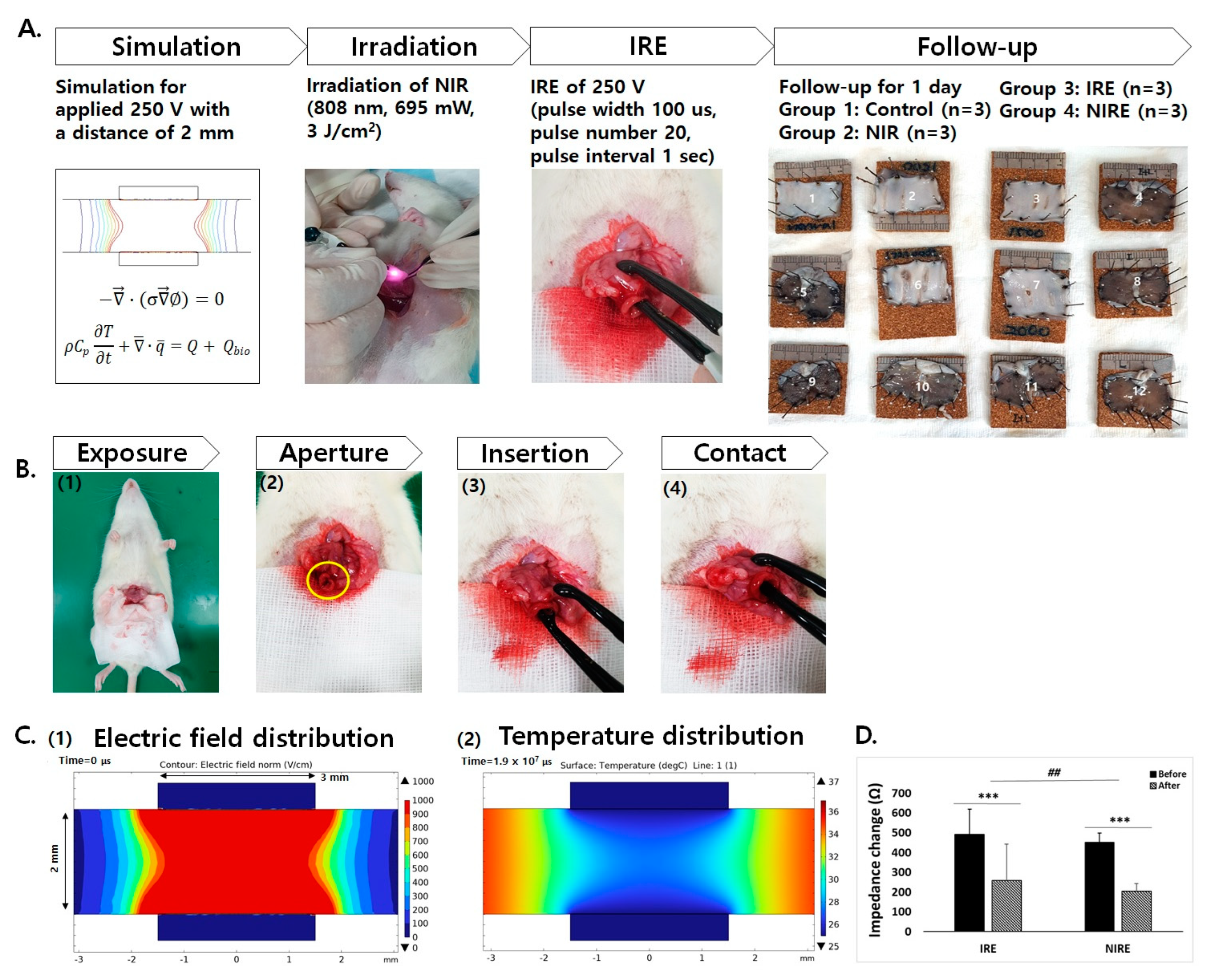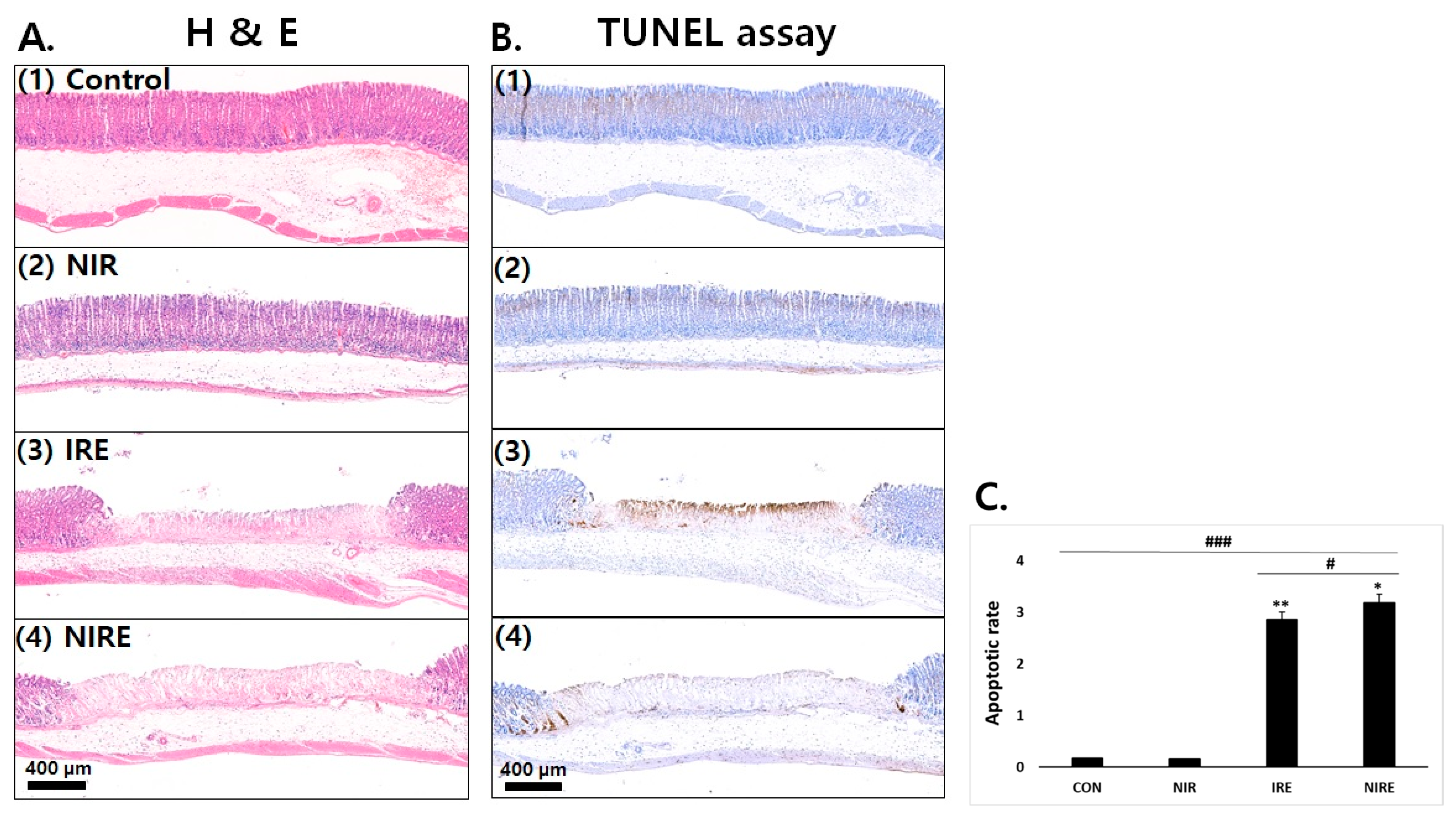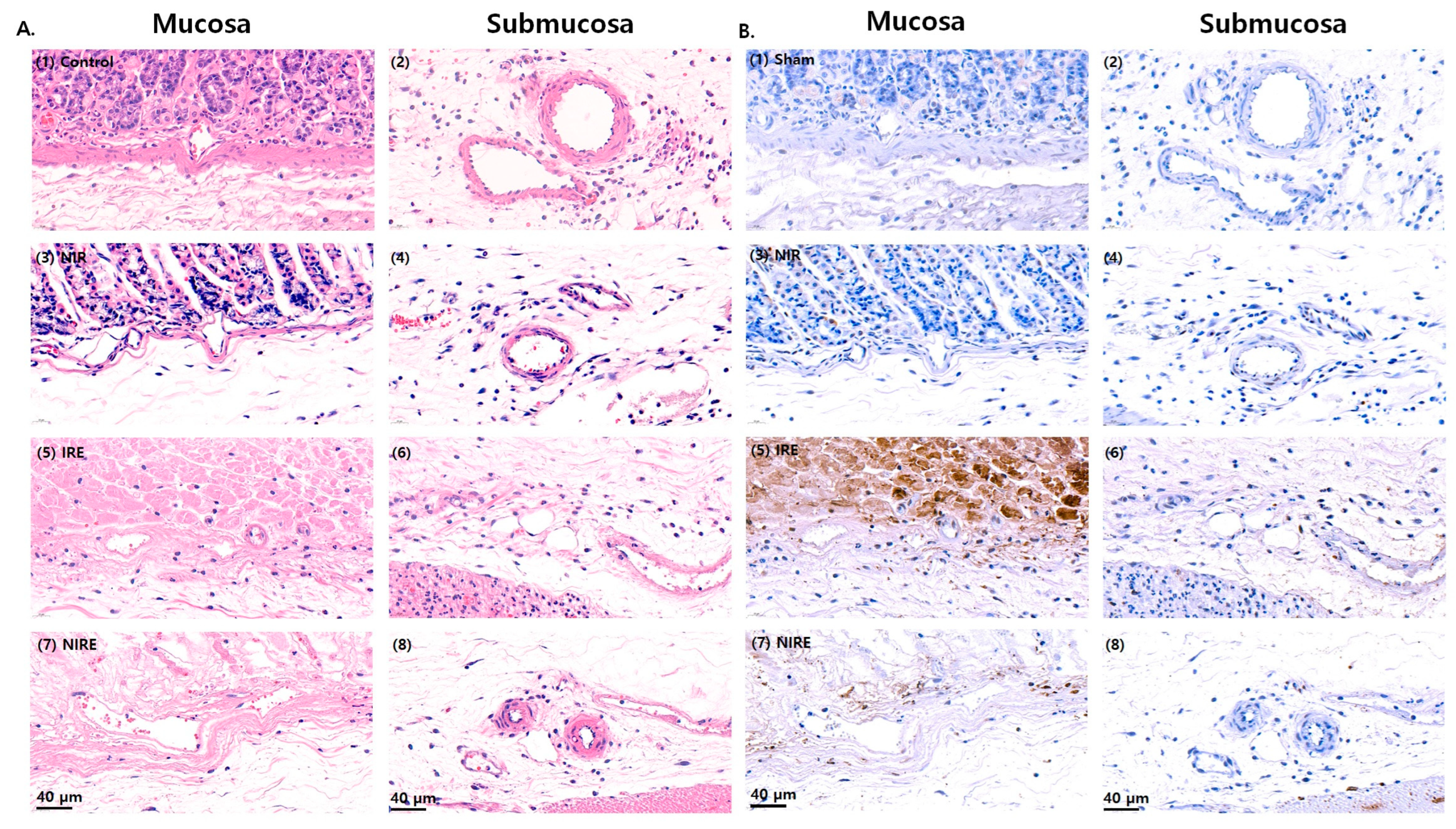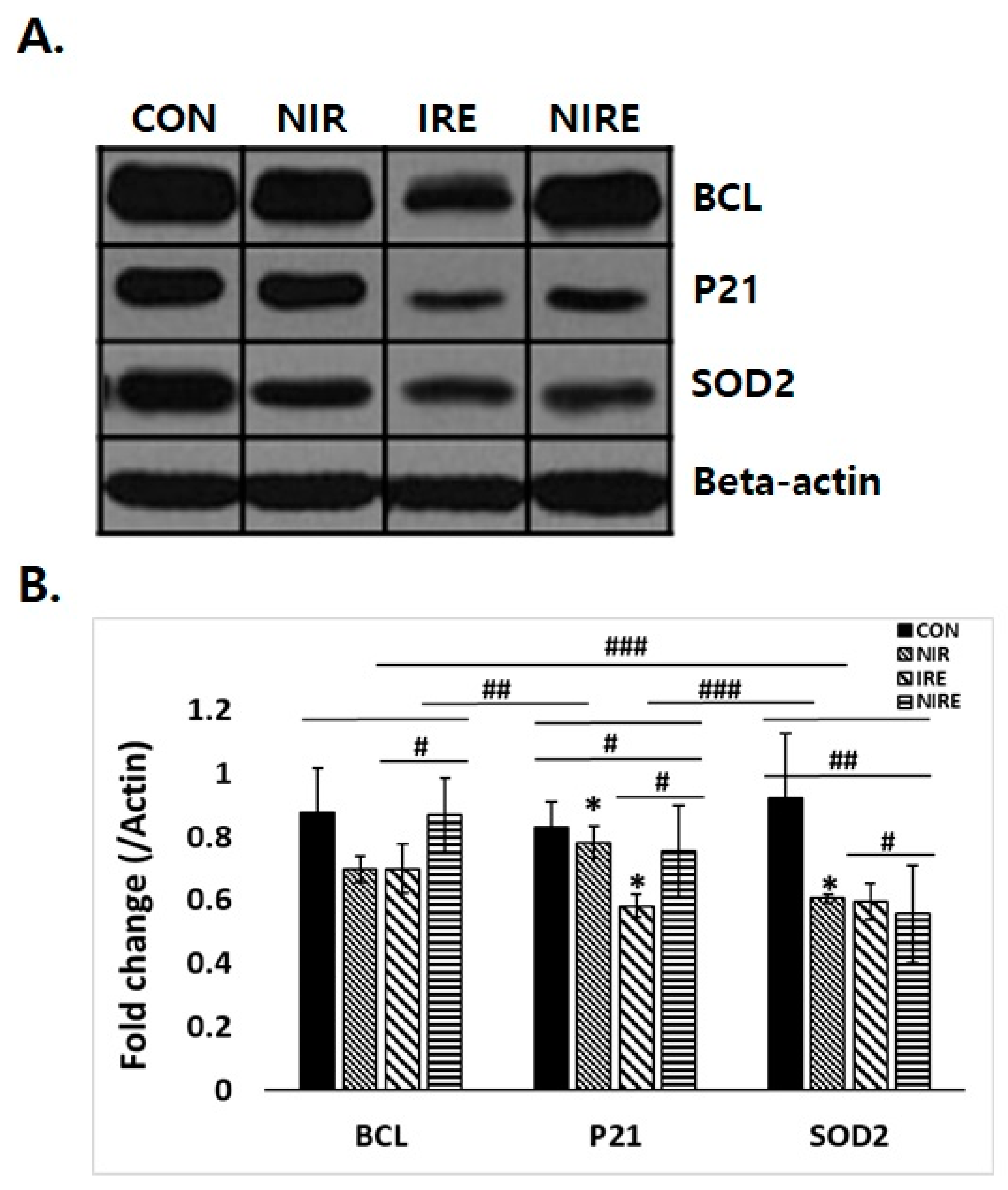Effect of Near-Infrared Pre-Irradiation on Irreversible Electroporation Treatment of Rat Gastric Tissues
Abstract
:1. Introduction
2. Materials and Methods
2.1. Numerical Analysis for Electric Field Distribution
2.2. Numerical Analysis for Temperature Distribution
2.3. Animals
2.4. IRE Procedure
2.5. Hematoxylin and Eosin Staining
2.6. TdT-Mediated dUTP-Biotin Nick End-Labeling Staining
2.7. Western Blotting Analysis
2.8. Statistical Analyses
3. Results
3.1. Impedance Analysis
3.2. Histopathological Analysis
3.3. Protein Expression Analysis Using Western Blotting
4. Discussion
5. Conclusions
Author Contributions
Funding
Institutional Review Board Statement
Informed Consent Statement
Data Availability Statement
Conflicts of Interest
References
- Davalos, R.V.; Mir, I.L.; Rubinsky, B. Tissue ablation with irreversible electroporation. Ann. Biomed. Eng. 2005, 33, 223–231. [Google Scholar] [CrossRef] [PubMed]
- Morozov, A.; Taratkin, M.; Barret, E.; Singla, N.; Bezrukov, E.; Chinenov, D.; Enikeev, M.; Gomez Rivas, J.; Shpikina, A.; Enikeev, D. A systematic review of irreversible electroporation in localised prostate cancer treatment. Andrologia 2020, 52, e13789. [Google Scholar] [CrossRef] [PubMed]
- Rudno-Rudzińska, J.; Kielan, W.; Guziński, M.; Kulbacka, J. Effects of calcium electroporation, electrochemotherapy, and irreversible electroporation on quality of life and progression-free survival in patients with pancreatic cancer: IREC clinical study. Adv. Clin. Exp. Med. 2021, 30, 765–770. [Google Scholar] [CrossRef] [PubMed]
- Geboers, B.; Scheffer, H.J.; Graybill, P.M.; Ruarus, A.H.; Nieuwenhuizen, S.; Puijk, R.S.; van den Tol, P.M.; Davalos, R.V.; Rubinsky, B.; de Gruijl, T.D.; et al. High-voltage electrical pulses in oncology: Irreversible electroporation, electrochemotherapy, gene electrotransfer, electrofusion, and electroimmunotherapy. Radiology 2020, 295, 254–272. [Google Scholar] [CrossRef]
- Sersa, G.; Jarm, T.; Kotnik, T.; Coer, A.; Podkrajsek, M.; Sentjurc, M.; Miklavcic, D.; Kadivec, M.; Kranjc, S.; Secerov, A.; et al. Vascular disrupting action of electroporation and electrochemotherapy with bleomycin in murine sarcoma. Br. J. Cancer 2008, 98, 388–398. [Google Scholar] [CrossRef]
- Lin, M.; Liang, S.; Wang, X.; Liang, Y.; Zhang, M.; Chen, J.; Niu, L.; Xu, K. Percutaneous irreversible electroporation combined with allogeneic natural killer cell immunotherapy for patients with unresectable (stage III/IV) pancreatic cancer: A promising treatment. J. Cancer Res. Clin. Oncol. 2017, 143, 2607–2618. [Google Scholar] [CrossRef]
- Campana, L.G.; Miklavčič, D.; Bertino, G.; Marconato, R.; Valpione, S.; Imarisio, I.; Dieci, M.V.; Granziera, E.; Cemazar, M.; Alaibac, M.; et al. Electrochemotherapy of superficial tumors—Current status:: Basic principles, operating procedures, shared indications, and emerging applications. Semin. Oncol. 2019, 46, 173–191. [Google Scholar] [CrossRef] [PubMed]
- Matthiessen, L.W.; Johannesen, H.H.; Hendel, H.W.; Moss, T.; Kamby, C.; Gehl, J. Electrochemotherapy for large cutaneous recurrence of breast cancer: A phase II clinical trial. Acta Oncol. 2012, 51, 713–721. [Google Scholar] [CrossRef]
- Gargiulo, M.; Papa, A.; Capasso, P.; Moio, M.; Cubicciotti, E.; Parascandolo, S. Electrochemotherapy for non-melanoma head and neck cancers: Clinical outcomes in 25 patients. Ann. Surg. 2012, 255, 1158–1164. [Google Scholar] [CrossRef]
- Frandsen, S.K.; Gissel, H.; Hojman, P.; Tramm, T.; Eriksen, J.; Gehl, J. Direct therapeutic applications of calcium electroporation to effectively induce tumor necrosis. Cancer Res. 2012, 72, 1336–1341. [Google Scholar] [CrossRef]
- Frandsen, S.K.; Gissel, H.; Hojman, P.; Eriksen, J.; Gehl, J. Calcium electroporation in three cell lines: A comparison of bleomycin and calcium, calcium compounds, and pulsing conditions. Biochim. Biophys. Acta 2014, 1840, 1204–1208. [Google Scholar] [CrossRef] [PubMed]
- Hansen, E.L.; Sozer, E.B.; Romeo, S.; Frandsen, S.K.; Vernier, P.T.; Gehl, J. Dose-dependent ATP depletion and cancer cell death following calcium electroporation, relative effect of calcium concentration and electric field strength. PLoS ONE 2015, 10, e0122973. [Google Scholar]
- Rudno-Rudzińska, J.; Kielan, W.; Guziński, M.; Płochocki, M.; Antończyk, A.; Kulbacka, J. New therapeutic strategy: Personalization of pancreatic cancer treatment-irreversible electroporation (IRE), electrochemotherapy (ECT) and calcium electroporation (CaEP)—A pilot preclinical study. Surg. Oncol. 2021, 38, 101634. [Google Scholar] [CrossRef] [PubMed]
- Clapham, D.E. Calcium signaling. Cell 2007, 131, 1047–1058. [Google Scholar] [CrossRef]
- Carafoli, E. Calcium signaling: A tale for all seasons. Proc. Natl. Acad. Sci. USA 2002, 99, 1115–1122. [Google Scholar] [CrossRef]
- Cerella, C.; Diederich, M.; Ghibelli, L. The dual role of calcium as messenger and stressor in cell damage, death, and survival. Int. J. Cell Biol. 2010, 2010, 546163. [Google Scholar] [CrossRef]
- Frandsen, S.K.; Gehl, J. Effect of calcium electroporation in combination with metformin in vivo and correlation between viability and intracellular ATP level after calcium electroporation in vitro. PLoS ONE 2017, 12, e0181839. [Google Scholar] [CrossRef]
- Chen, Y.; Moser, M.A.J.; Luo, Y.; Zhang, W.; Zhang, B. Chemical enhancement of irreversible electroporation: A review and future suggestions. Technol. Cancer Res. Treat. 2019, 18, 1533033819874128. [Google Scholar] [CrossRef]
- Kim, H.B.; Jeong, S.; Baik, K.Y. Preconditioning with near-infrared irradiation to enhance the irreversible electroporation efficiency in HeLa cells. Appl. Sci. 2021, 11, 8504. [Google Scholar] [CrossRef]
- Smith, A.M.; Mancini, M.C.; Nie, S. Bioimaging: Second window for in vivo imaging. Nat. Nanotechnol. 2009, 4, 710–711. [Google Scholar] [CrossRef]
- Golovynska, I.; Golovynskyi, S.; Stepanov, Y.V.; Stepanova, L.I.; Qu, J.; Ohulchanskyy, T.Y. Red and near-infrared light evokes Ca2+ influx, endoplasmic reticulum release and membrane depolarization in neurons and cancer cells. J. Photochem. Photobiol. B 2021, 214, 112088. [Google Scholar] [CrossRef] [PubMed]
- Kim, H.B.; Baik, K.Y.; Seonwoo, H.; Jang, K.J.; Lee, M.C.; Choung, P.H.; Chung, J.H. Effects of pulsing of light on the dentinogenesis of dental pulp stem cells in vitro. Sci. Rep. 2018, 8, 2057. [Google Scholar] [CrossRef] [PubMed]
- Kennedy, S.M.; Aiken, E.J.; Beres, K.A.; Hahn, A.R.; Kamin, S.J.; Hagness, S.C.; Booske, J.H.; Murphy, W.L. Cationic peptide exposure enhances pulsed-electric-field-mediated membrane disruption. PLoS ONE 2014, 9, e92528. [Google Scholar] [CrossRef]
- Aiken, E.J.; Kilberg, B.G.; Yu, S.; Hagness, S.C.; Booske, J.H. Ionomycin-induced changes in membrane potential alter electroporation outcomes in HL-60 cells. Biophys. J. 2018, 114, 2875–2886. [Google Scholar] [CrossRef]
- Frandsen, S.K.; Gehl, J. A review on differences in effects on normal and malignant cells and tissues to electroporation-based therapies: A focus on calcium electroporation. Technol. Cancer Res. Treat. 2018, 17, 1533033818788077. [Google Scholar] [CrossRef]
- Kim, H.B.; Lee, S.; Shen, Y.; Ryu, P.D.; Lee, Y.; Chung, J.H.; Sung, C.K.; Baik, K.Y. Physicochemical factors that affect electroporation of lung cancer and normal cell lines. Biochem. Biophys. Res. Commun. 2019, 517, 703–708. [Google Scholar] [CrossRef] [PubMed]
- Kim, H.B.; Lee, S.; Chung, J.H.; Kim, S.N.; Sung, C.K.; Baik, K.Y. Effects of actin cytoskeleton disruption on electroporation in vitro. Appl. Biochem. Biotechnol. 2020, 191, 1545–1561. [Google Scholar] [CrossRef]
- Sabrina, N.C.; Melvin, F.L.; Brittanie, P.; Nastaran, A.; Yukitaka, K.; Josefa, G.; Sofie, S.; Sean, C.T.; Jonathan, H.; Scott, V.; et al. High-frequency irreversible electroporation improves survival and immune cell infiltration in rodents with malignant gliomas. Front. Oncol. 2023, 13, 1171278. [Google Scholar]
- Ho, C.Y.; Chu, T.L. Electrical Resistivity and Thermal Conductivity of Nine Selected AISI Stainless Steels; Center for Information and Numerical Data Analysis and Synthesis, Purdue University: West Lafayette, IN, USA, 1977. [Google Scholar]
- Choi, Y.S.; Kim, H.B.; Chung, J.; Kim, H.S.; Yi, J.H.; Park, J.K. Preclinical analysis of irreversible electroporation on rat liver tissues using a microfabricated electroporator. Tissue Eng. Part C Methods 2010, 16, 1245–1253. [Google Scholar] [CrossRef]
- Shaul, O.; Fanrazi-Kahana, M.; Meitav, O.; Pinhasi, G.A.; Abookasis, D. Application of spatially modulated near-infrared structured light to study changes in optical properties of mouse brain tissue during heatstress. Appl. Opt. 2017, 56, 8880–8886. [Google Scholar] [CrossRef]
- Praveen, R.A.; Andrew, C.; Tristan, D.H.; Gursimran, S.; Kyungsup, S.; Eason, H.; George, X.H.; James, W.; Aaron, C.H.; Bonnie, L.P.; et al. Photoactivation of endogenous latent transforming growth factor-β1 directs dental stem cell differentiation for regeneration. Sci. Transl. Med. 2014, 28, 238ra69. [Google Scholar]
- Razmik, M.; David, M. Do tunel and other apoptosis assays detect cell death in preclinical studies? Int. J. Mol. Sci. 2020, 21, 9090. [Google Scholar]
- Elmore, S. Apoptosis: A review of programmed cell death. Toxicol. Pathol. 2007, 35, 495–516. [Google Scholar] [CrossRef] [PubMed]
- Korsmeyer, S.J. Regulators of cell death. Trends Genet. 1995, 11, 101–105. [Google Scholar] [CrossRef] [PubMed]
- Gartel, A.L.; Radhakrishnan, S.K. Lost in transcription: p21 repression, mechanisms, and consequences. Cancer Res. 2005, 65, 3980–3985. [Google Scholar] [CrossRef]
- Becuwe, P.; Ennen, M.; Klotz, R.; Barbieux, C.; Grandemange, S. Manganese superoxide dismutase in breast cancer: From molecular mechanisms of gene regulation to biological and clinical significance. Free Radic. Biol. Med. 2014, 77, 139–151. [Google Scholar] [CrossRef]
- Michel, O.; Kulbacka, J.; Saczko, J.; Mączyńska, J.; Błasiak, P.; Rossowska, J.; Rzechonek, A. Electroporation with cisplatin against metastatic pancreatic cancer: In vitro study on human primary cell culture. Biomed. Res. Int. 2018, 2018, 7364539. [Google Scholar] [CrossRef]
- Dovgan, B.; Miklavcic, D.; Knezevic, M.; Zupan, J.; Barlic, A. Intracellular delivery of trehalose renders mesenchymal stromal cells viable and immunomodulatory competent after cryopreservation. Cytotechnology 2021, 73, 391–411. [Google Scholar] [CrossRef]
- Qin, Q.; Xiong, Z.A.; Liu, Y.; Yao, C.G.; Zhou, W.; Hua, Y.Y.; Wang, Z.L. Effects of irreversible electroporation on cervical cancer cell lines in vitro. Mol. Med. Rep. 2016, 14, 2187–2193. [Google Scholar] [CrossRef]
- Tian, G.; Guan, J.; Chu, Y.; Zhao, Q.; Jiang, T. Immunomodulatory effect of irreversible electroporation alone and its cooperating with immunotherapy in pancreatic cancer. Front. Oncol. 2021, 11, 712042. [Google Scholar] [CrossRef]
- Li, M.; Wang, D.; He, J.; Chen, L.; Li, H. Bcl-XL: A multifunctional anti-apoptotic protein. Pharmacol. Res. 2020, 151, 104547. [Google Scholar] [CrossRef]
- Fernald, K.; Kurokawa, M. Evading apoptosis in cancer. Trends Cell. Biol. 2013, 23, 620–633. [Google Scholar] [CrossRef] [PubMed]
- Finucane, D.M.; Bossy, W.E.; Waterhouse, N.J.; Cotter, T.G.; Green, D.R. Bax-induced caspase activation and apoptosis via cytochrome c release from mitochondria is inhibitable by Bcl-xL. J. Biol. Chem. 1999, 274, 2225–2233. [Google Scholar] [CrossRef] [PubMed]
- He, G.; Siddik, Z.H.; Huang, Z.; Wang, R.; Koomen, J.; Kobayashi, R.; Khokhar, A.R.; Kuang, J. Induction of p21 by p53 following DNA damage inhibits both Cdk4 and Cdk2 activities. Oncogene 2005, 24, 2929–2943. [Google Scholar] [CrossRef] [PubMed]
- Almond, J.B.; Cohen, G.M. The proteasome: A novel target for cancer chemotherapy. Leukemia 2002, 16, 433–443. [Google Scholar] [CrossRef] [PubMed]
- Fragkos, M.; Jurvansuu, J.; Beard, P. H2AX is required for cell cycle arrest via the p53/p21 pathway. Mol. Cell. Biol. 2009, 29, 2828–2840. [Google Scholar] [CrossRef]
- Pias, E.K.; Ekshyyan, O.Y.; Rhoads, C.A.; Fuseler, J.; Harrison, L.; Aw, T.Y. Differential effects of superoxide dismutase isoform expression on hydroperoxide-induced apoptosis in PC-12 cells. J. Biol. Chem. 2003, 278, 13294–13301. [Google Scholar] [CrossRef]
- Jeon, H.J.; Choi, H.S.; Keum, B.; Bang, E.J.; Lee, K.W.; Kim, S.H.; Yim, S.Y.; Lee, J.M.; Kim, E.S.; Seo, Y.S.; et al. Feasibility and effectiveness of endoscopic irreversible electroporation for the upper gastrointestinal tract: An experimental animal study. Sci. Rep. 2021, 11, 15353. [Google Scholar] [CrossRef]





| No. | Control | Group 1 (IRE) | Group 2 (NIR) | Group 3 (NIRE) |
|---|---|---|---|---|
| 1 | No treatment | Applied voltage: 250 V | λ: 808 nm | NIR + IRE |
| 2 | Pulsing: 20 | Power density: 695 mW | ||
| 3 | Pulse duration: 100 µs | Energy density: 3 J/cm2 | ||
| 4 | Pulse interval: 1 s | - | ||
| 5 | Electrode distance: 2 mm | - |
Disclaimer/Publisher’s Note: The statements, opinions and data contained in all publications are solely those of the individual author(s) and contributor(s) and not of MDPI and/or the editor(s). MDPI and/or the editor(s) disclaim responsibility for any injury to people or property resulting from any ideas, methods, instructions or products referred to in the content. |
© 2023 by the authors. Licensee MDPI, Basel, Switzerland. This article is an open access article distributed under the terms and conditions of the Creative Commons Attribution (CC BY) license (https://creativecommons.org/licenses/by/4.0/).
Share and Cite
Jeon, H.J.; Kim, H.B.; Yim, S.Y.; Lee, J.M.; Choi, H.S.; Kim, E.S.; Seo, Y.S.; Jeen, Y.T.; Lee, H.S.; Chun, H.J.; et al. Effect of Near-Infrared Pre-Irradiation on Irreversible Electroporation Treatment of Rat Gastric Tissues. Appl. Sci. 2023, 13, 10404. https://doi.org/10.3390/app131810404
Jeon HJ, Kim HB, Yim SY, Lee JM, Choi HS, Kim ES, Seo YS, Jeen YT, Lee HS, Chun HJ, et al. Effect of Near-Infrared Pre-Irradiation on Irreversible Electroporation Treatment of Rat Gastric Tissues. Applied Sciences. 2023; 13(18):10404. https://doi.org/10.3390/app131810404
Chicago/Turabian StyleJeon, Han Jo, Hong Bae Kim, Sun Young Yim, Jae Min Lee, Hyuk Soon Choi, Eun Sun Kim, Yeon Seok Seo, Yoon Tae Jeen, Hong Sik Lee, Hoon Jai Chun, and et al. 2023. "Effect of Near-Infrared Pre-Irradiation on Irreversible Electroporation Treatment of Rat Gastric Tissues" Applied Sciences 13, no. 18: 10404. https://doi.org/10.3390/app131810404






